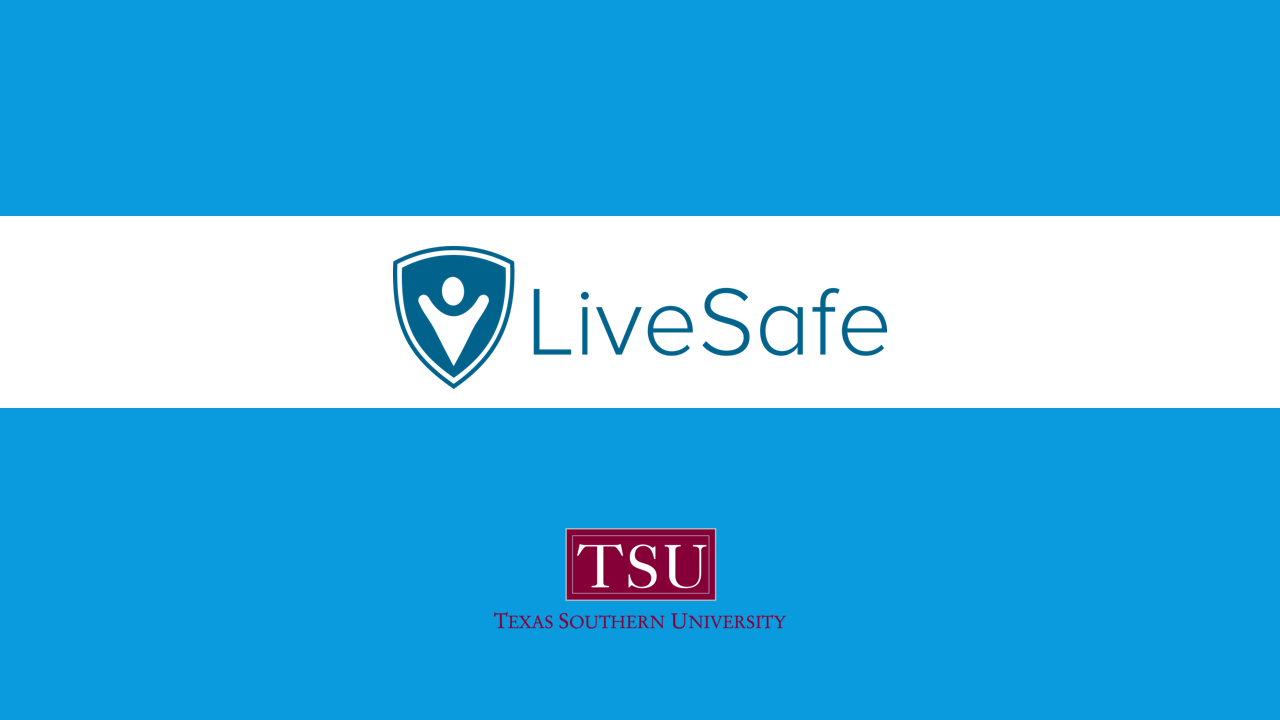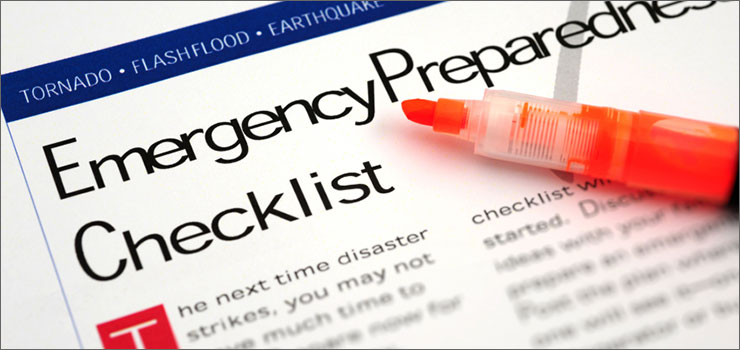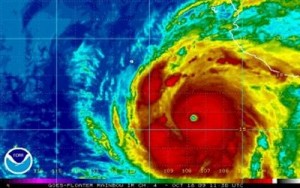What should you do in an emergency?
Safety is a top priority at Texas Southern University—and here is a source for all up-to-date, official information concerning emergency preparations and operations at the University.
Services

Texas Southern University is providing all students, faculty, and staff with the LiveSafe app – a safety tool that provides a quick, convenient, and discreet way to communicate with TSU Police.
Download LiveSafe for free from the Apple App Store or Google Play to enhance your overall safety and allow TSU Police to better protect you.
Use LiveSafe to:
- Share info: Easily share safety information and Police concerns directly to TSU Police using text, picture, and video.
- Stay up-to-date: Receive important alerts and notifications from TSU Police, and access important phone numbers and safety resources.
- Request an escort: Request an in-person escort from TSU Police to safely get you where you need to go Share your location: Share your location with safety officials in an emergency, or use location-tracking with friends, family, and colleagues for everyday safety.
Get LiveSafe by:
- Download “LiveSafe” from here: http://bit.ly/TSU-LiveSafe (Be sure to enable location services and push notifications when prompted!).
- Sign up using your mobile phone number.
- Create a password and fill in your name.
- Add your email address to your profile (Left Menu > Settings > Profile).

- Assist others in your immediate area that may be unfamiliar with the space.
- If you are in an unshaded area, proceed cautiously to an area with emergency lights.
- If you are in an elevator, remain calm. Use the emergency button or telephone to alert DPS.
- If instructed to evacuate an area, proceed cautiously to the nearest exit.
- Dial (713) 313-7000 or the Non-Emergency at (713) 313-7001
- Initiate power outage protocols for critical operations such as fume hoods.

If a water leak occurs:
- Remain calm, notify (713) 313-7000 first.
- If there are electrical appliances or outlets near the leak, use extreme caution. If there is any possible danger, evacuate the area.
- If you know the water source and are confident of your ability to stop it (i.e., unclog the drain, turn off the water, Etc.), do so.
- Be prepared to assist as directed in protecting objects that are in jeopardy. Take only essential steps to avoid or reduce immediate water damage, such as covering things with plastic sheeting or moving small or light objects out of danger.
- If you must step outside, do so, but do not leave the area until emergency patrol arrives.

If someone becomes ill or is injured and requires immediate assistance,
- Dial (713) 313-7000 to contact Dispatch.
- Police will provide required services.
- Unless trained do not attempt to render any first aid before trained assistance arrives. Keep the victim calm. Direct or have someone direct the first responder to the scene of the emergency.
- Do not attempt to move a person who has fallen and appears to be in pain.
- Reassure the ill or injured person; do not comment on the illness or injury.
- After the person’s immediate needs have been taken care of, remain at the scene and provide information as requested.
- If the victim is a staff member, the victim’s supervisor should fill out the University’s “Accident Report” relative to the incident.
- Planning for such emergencies includes being trained in emergency first aid procedures and CPR.
For any minor illness, please contact the Student Health Center for assistance:
- Clinic Hours: Monday – Friday 8 AM – 5 PM
- Phone: 713-313-7173
- After-hours Nurse Advice Line (833) 631-107213
Tornado/ Severe Weather
A tornado warning is the sounding of the emergency sirens for three minutes followed by seven minutes of silence. A sign indicates a tornado has been sighted by ground observers or appeared on Greene County radar.
- Stay inside and be alert to falling objects.
- If possible, leave temporary or lightly built structures for nearby structures that are sound in their construction. YOUR DISTANCE OF TRAVEL SHOULD BE NO MORE THAN 50 YARDS TO THE SECURE SITE.
- Stay away from windows, mirrors, glass, and unsecured objects such as filing cabinets or bookcases.
- Proceed to a below ground level or central hallway of the building if possible.
- Do not use elevators.
- If requested, assist persons with disabilities to the safest area on the same floor.
- Remain in the safe area until at least 10 minutes have elapsed without the sirens sounding or the “all clear” has been given.
- Planning includes identifying the appropriate buildings and places in your building to seek shelter should a tornado occur.

CHEMICALS, LEAKING GAS, FAULTY BOILERS, OR FALLING AIRCRAFT COULD ALL BE THE CAUSE OF LIFE-ENDANGERING EXPLOSIONS. n
- Remain calm & call (713) 313-7000. Brace yourself in the case of another explosion following.
- Seek shelter and crawl under a table or desk.
- Stay away from windows, mirrors, overhead fixtures, filing cabinets, bookcases, and electrical equipment.
- Be guided by the instructions of DPS. If an evacuation is ordered, proceed to one of the designated exits.
- Do not move seriously injured persons unless they are in immediate danger (fire, building collapse, Etc.)
- Open doors carefully and watch for falling objects.
- Absolutely do not use any elevators.
- Upon request, accompany, and assist persons with disabilities who appear to need direction or assistance.
- Do not use matches or lighters.
- When recognizing the sound of the evacuation alarm, remain calm.
- Gather your purse or wallet and leave quickly.
- When requested, accompany, and assist persons with disabilities who appear to need direction or assistance.
- Shut all doors behind you as you go. Closed doors can slow the spread of fire, smoke, and water.
- Proceed as quickly as possible but in an orderly manner. Do not push or shove. Hold handrails when you are walking on stairs.
- Once out of the building, move away at least 100 feet from the structure or as instructed by DPS.
How to Report a Fire
- If a burning odor or smoke is present, Dial 9-911. Report the exact location of the fire and, if known, what is burning. If a fire is detected, sound the building alarm by pulling an alarm station.
- A local alarm station will cause the alarm horns to sound. It automatically notifies the dispatcher.
- Never allow the fire to come between you and an exit.
- Remove all persons from the danger area. Close doors behind you to confine the fire.
Respond to Audible Fire Alarms
- If the audible horn alarms sound for more than 30 seconds or start to sound for a second time, evacuate the building.
- Do not use the elevators.
- When requested, accompany, and assist persons with disabilities who appear to need direction or assistance.
- Leave all parcels and personal property inside.
- Remain approximately 100 feet from the exits to help facilitate clear access to the building for the Fire Department.
- Return to the building only when instructed to do so by Police or Fire Department officials

Chemical Spill:
- If toxic chemicals contact your skin, immediately flush the affected area with water.
- Call Dispatch (713) 313-7000 IMMEDIATELY
- If there is any continued possible danger, evacuate your area.
A Chemical Fire:
- Remain calm.
- Call Dispatch (713) 313-7000
- If the fire is small and you have received training, attempt to put it out with a fire extinguisher or other available means. Do not jeopardize your safety.
- Never allow the fire to come between you and an exit.
- Evacuate your area if you are unable to put out the fire. Close doors and windows behind you to confine the fire. Proceed to an exit.
- Do not break windows. Oxygen feeds a fire.
- Do not attempt to save possessions at the risk of personal injury.
- Do not return to the emergency area until instructed by Police or Fire Department officials.
- All chemical spills and fires should be reported to the Department of Public Safety, no matter how small.

A bomb threat may come to the attention of an employee in various ways and it is important to compile as much information about the situation as possible.
REMAIN CALM!
- If the threat is received by phone, keep the caller on the line and obtain as much info as possible
- If you see a suspicious object, do not touch or move it. Move away and contact DPS (713) 313-7000.
- If a written threat is received, handle it as little as possible, note when you receive it, and call DPS IMMEDIATELY!

In Your Office:
- Lock your door, even if you are going down the hall. It takes a thief ten seconds or less to enter an open room and steal your property.
- Do not leave messages on your door indicating that you are away and when you will be back.
- If someone asks to use your phone for an emergency call, offer to telephone for them instead of allowing them access.
- Do not put your address on your key ring.
- Do not leave keys in hiding places.
- Call DPS at (713) 313-7000 to report suspicious persons or activity.
When Walking:
- Avoid walking alone at night unless necessary.
Walk purposefully; know where you are going, project a no-nonsense image.
Carry a whistle to sound an alarm in the event of threats.
Protecting Your Auto or Bicycle:
- Always lock your car.
- Lock bikes to immovable objects or bike racks with hardened alloy locks and chains or U-shaped locks.
- Do not leave tempting valuables or property visible inside the car. Lock these items in the trunk.
Protect Yourself When Driving:
- Look into your car before getting in. Lock doors and roll-up windows once inside for protection.
- Do not stop to help occupants of stopped or disabled vehicles. Continue driving to the nearest phone and call assistance for them or use your cell phone.
- If your car breaks down, raise the hood and lock yourself into your vehicle. If someone stops and offers you help, remain in your car and ask them to phone for help.

Emergency Operations Center (EOC) is located in the Department of Public Safety headquarters, General Services Building, Suite #217, TSU, 3100 Cleburne, Houston, Texas 77004.
| Police Emergency: 713-313-7000 | |
|---|---|
| Police Non-Emergency: 713-313-7001 | |
| EOC & Safety Department: 713-313-5001 | |
| EOC & Safety Department: 713-313-5002 | |
| Parking Enforcement: 713-313-4432 | |
| Crime Prevention: 713-313-7198 | |
| Investigations: 713-313-5502 | |
| TSU Counseling & Psychological Services: 713-313-7804 | |
| TSU Health Center: 713-313-7173 | |
| TSU Title IX Coordinator: 713-313-7037 | |
| Rape Crisis Center: 713-528-7273 | |
| Domestic Violence Hotline and Shelter: 713-528-2121 | |
| Houston Area Women’s Center: 713-528-6798 | |
